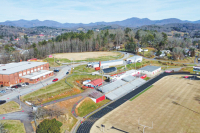Seeing nature through new eyes
When Mickey Henson looks at a creek, he sees a physics equation.
The volume of water, the slope of the stream bed, its width and depth and the angle of its twists and turns form an instant mathematical formula, one that explains why the stream looks and acts the way it does.
But Henson’s view of nature is also like a blank canvas. What looks like a brambly field to most is waiting for a wetland to spring to life. A few strokes here and there, and a choked ditch barely carrying water can turn into a meandering trout stream.
“They always say stream restoration is part-art, part-science,” Henson said.
Mickey Henson and his wife, Rebecca, own Appalachian Environmental Services, a Sylva-based firm that repairs the environment. They make a living designing and building wetlands and creeks, restoring one slice of the earth at a time to its natural conditions and disguising the signs of human interference and contamination.
Over the years, Mickey, whose background is in physics, has internalized all those equations, reducing the science to instinct at times.
“Usually when I see a site, within the first five minutes, I know what it is going to look like,” Mickey said.
But knowing how each variable in a stream affects its behavior — a science known as geomorphology — is critical to knowing which ones to tweak to transform a broken ecosystem into a healthy one. In one project, something as benign as bridge pilings were altering the natural flow and causing erosion downstream.
Americans have become acutely aware of the consequences of toying with hydrology, thanks to the numerous scientists being invited to opine on national television about Louisiana’s fate during Hurricane Katrina. An extensive network of bayous and wetlands once buffered the Gulf communities. But the construction of levees harnessing the Mississippi put a stop to a timeless ebb and flow of the river’s delta. In hindsight, scientists realized that the natural cycle was crucial to the health and survival of the wetland buffer, and the ocean has reclaimed hundreds of square miles of those wetlands.
“They are trying to control Mother Nature, and that is impossible,” Mickey said.
The Henson’s make their living turning the tide the other way — putting nature back the way it is supposed to be.
“When you go back to a site in a couple years, it doesn’t look manicured. It looks like mother nature created that,” Rebecca said. “We want it to look like it has always been that way, to look like it is pristine.”
When forced to pick a favorite type of project, Rebecca sided with building wetlands.
“I like the wetlands just because it is almost instantaneous that you get the wildlife,” Rebecca said. “Before we had even finished this one project, we had these little green birds and you had the frogs and you had the dragonflies. It was like instant gratification. Build it and they will come. It is so true.”
Before starting Appalachian Environmental, Mickey worked as a state environmental regulator in Raleigh. His job was visiting construction sites in 100 counties to see how streams were being treated. Eventually, Rebecca hounded him into starting his own firm.
“She saw my passion for streams and didn’t see me as a paper pusher or regulator. She said ‘Why don’t you just break loose and do it?’” Mickey said.
Rebecca’s version didn’t sound quite so simple.
“It took me four years to talk him into starting this business,” Rebecca said. “When he was with the state he saw a lot of these plans coming across his desk. He would go out and look at the site and say, ‘This is nothing like the plan. This is not how it is supposed to be.’”
Rebecca and Mickey, both 36, grew up in Jackson County and were in the same grade in school. Rebecca moved away in high school and it wasn’t until their mid 20s when they ran into each other and “got reacquainted,” according to Mickey.
When they finally started the firm, moving back to Sylva was a given. People in the mountains, more so than elsewhere, value the environment.
“A lot of people like their streams,” Mickey said. “When we are out educating people, if you can tie it back to trout fishing you really hit home.”
Appalachian Environmental Services gets enough work in the region to support nine full-time employees. But just seven years ago when the Hensons started Appalachian Environmental Services, the concept of a private firm that would get paid to build creeks and wetlands was somewhat foreign.
“Stream restoration was still in its infancy at that time. We not only had to sell what we were doing, but we had to sell ourselves, that we could do it,” Mickey said. “It started changing somewhat five years ago, where you didn’t really have to sell what you were doing anymore, you just had to sell your qualifications. The environmental world started changing at that time and water quality became a real issue.”





